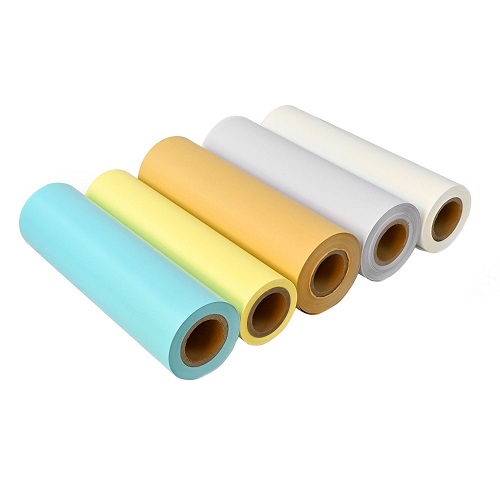Release Paper Types: A Guide for Manufacturers
At Targanix, we appreciate the importance of choosing the right release paper when working with projects from different industries. Release papers can be vital features in a number of processes, including the production of pressure-sensitive adhesives and even the design of sophisticated medical devices. Knowing the characteristics of various release papers is crucial for increasing production efficiency, reducing losses, and ensuring the operational performance of the finished products.
1. Silicone-coated Release Paper
Silicone-coated release paper reigns supreme in terms of release performance. A thin layer of silicone is applied to the paper's surface, creating a highly non-stick barrier with exceptional release properties.
Features:
● Unique Release: Where the level of difficulty while trying to release adhesives is quite low, it is said that this unique release creates no bond at all.
● Heat Resistance: Capable of handling high temperatures experienced in most manufacturing operations.
● Chemical Resistance: Displays no effects when exposed to a large number of solvents and chemicals.
● Variety: Present in an extensive range of thicknesses and silicone compositions to suit different applications.
Applications:
● Pressure sensitivity: employed in the assembly of tapes, labels, and adhesive-backed products.
● Food Packaging: Filter includes baking liners, candy wrappers, and non-stick utensils.
● Medical Applications: The release of medical-grade adhesives used for surgery, injured skin, bandages, and other devices attaches itself.
● Graphic Arts: It is used in printing blankets for various printing processes.
2. Polyethylene-coated Release Paper
Low- to moderate-releasing-strength applications can be efficiently done with polyethylene-coated release paper. This coating of polyethylene assists in preparing a non-sticking surface for numerous materials.
Features:
● Good Release Properties: Can achieve release of many adhesives and other materials as well.
● Moisture Resistance: Suitable against moisture and humidity that prolongs the life of the product.
● Low Production Cost: Relatively inexpensive when compared to certain highly priced release paper types.
Applications:
● Label Stock Liners: They are frequently utilized as a backing for labels.
● Medical Device Liners: Assists in the fabrication of multiple medical devices and their parts.
● Composite Materials Processing: Acts as a release surface to ease the fabrication of composite materials.
● Protective Packaging: For covering machined surfaces during transport and avoidance of damage.
3. Fluoropolymer-coated Release Paper
The fluoropolymer-coated release paper, largely based on PTFE (commonly known as Teflon), is regarded to provide the highest level of release performance among the other papers. This kind of release paper provides excellent non-stick and effective properties.
Features:
● Superior Release: Overall, the best release characteristics tend to be found in adhesive papers or even more advanced ones having very specialized adhesives.
● Low Surface Energy: Have a very minimal
Applications:
● High-Performance Tapes and Adhesives: Ideal for demanding applications requiring exceptional release.
● Medical Applications: Critical for applications requiring minimal adhesion, such as catheter liners and surgical tapes.
● Specialty Packaging: Protects sensitive materials during storage and transportation.
Applications
● Requiring Extreme Heat Resistance: Utilized in high-temperature industrial processes.
4. Glassine Release Paper
The glassine release paper is a translucent paper that is chemically glazed and has a smooth, non-stick surface. Delivering a compromise between cost and medium-tier launch prowess.
Features:
● Control Release Characteristics: Rapidly discharges different adhesives with moderate tack.
● Resistance to Grease: Barrier for oils and greasy materials.
● Translucency: Makes it easy to visually inspect underlying materials.
Applications:
● Food Packaging: To be used as greaseproof liners within food products.
● Pharmaceutical Packaging: Helps in the packaging of different types of pharmaceutical products.
● Liner: Pressure-Sensitive Adhesive: For low-tack adhesive.
5. Non-Silicone Coated Release Paper
This type of release paper employ different coatings and treatments for generating the desired release properties. These papers have unique benefits and are suitable for particular application needs.
Features:
● Custom Release Properties: Release properties are modified according to the requirements of the application.
● Printability Potential: Certain non-silicone coated papers can be printed on, allowing for custom branding and labeling.
● Recyclability: Some non-silicone alternatives might be recycled more easily, depending on the coating.
Applications:
● Areas of Use: These differ greatly among the various coatings and treatments.
● Great for Specialty Applications: Excellent for those applications where silicone might not be appropriate or preferred.
6. Polyester-coated Release Paper
Release paper is polyester-coated release paper. Similar uses included the polyester film, which gave a smooth, nonstick surface with excellent heat resistance.
Features:
● Easy Release: Quickly releases many different types of adhesives with minimal drag.
● Prestigious Dimensional Stability: Retains its shape and size even under various temperature and humidity conditions.
● Heat Resistant: Resistant to high temperatures, no deformation.
● Chemical Resistant: Does not affect a wide range of chemicals and solvents.
Applications:
● Heavy-duty tapes and labels: designed for tough applications needing superior performance.
● Graphic Arts: used in printing blankets for high-quality printing applications.
● Manufacturing of Electronic Components: Supports the manufacturing of electronic elements
● Industrial Applications: Used in severe industrial environments or applications that need high heat and chemical resistance.
Conclusion
At Targanix, we pride ourselves on providing manufacturers with the best release paper options for their specific production challenges. With diverse release paper types, coatings, and customizations available to meet needs in the most complex applications.
Remember, a proper release paper can boost the efficiency of your manufacturing process, reduce waste, and deliver a better product. Try to consider a few things first before you make your choice.

- Previous:What is a Release Paper?
- Next:What is Release Paper Made Of?
